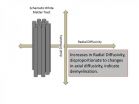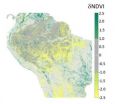With natural gas production in the United States expected to continue to increase during the next few decades, there is a need for a better understanding of methane emissions during natural gas production. The study team believes this research, published Dec. 9 in Environmental Science & Technology, will help to provide a clearer picture of methane emissions from natural gas production sites.
The UT Austin-led field study closely examined two major sources of methane emissions -- liquid unloadings and pneumatic controller equipment -- at well pad sites across the United States. Researchers found that 19 percent of the pneumatic devices accounted for 95 percent of the emissions from pneumatic devices, and 20 percent of the wells with unloading emissions that vent to the atmosphere accounted for 65 percent to 83 percent of those emissions.
"To put this in perspective, over the past several decades, 10 percent of the cars on the road have been responsible for the majority of automotive exhaust pollution," said David Allen, chemical engineering professor at the Cockrell School and principal investigator for the study. "Similarly, a small group of sources within these two categories are responsible for the vast majority of pneumatic and unloading emissions at natural gas production sites."
Additionally, for pneumatic devices, the study confirmed regional differences in methane emissions first reported by the study team in 2013. The researchers found that methane emissions from pneumatic devices were highest in the Gulf Coast and lowest in the Rocky Mountains.
The study is the second phase of the team's 2013 study, which included some of the first measurements for methane emissions taken directly at hydraulically fractured well sites. Both phases of the study involved a partnership between the Environmental Defense Fund, participating energy companies, an independent Scientific Advisory Panel and the UT Austin study team.
The unprecedented access to natural gas production facilities and equipment allowed researchers to acquire direct measurements of methane emissions.
Study and Findings on Pneumatic Devices
Pneumatic devices, which use gas pressure to control the opening and closing of valves, emit gas as they operate. These emissions are estimated to be among the larger sources of methane emissions from the natural gas supply chain. The Environmental Protection Agency reports that 477,606 pneumatic (gas actuated) devices are in use at natural gas production sites throughout the U.S.
"Our team's previous work established that pneumatics are a major contributor to emissions," Allen said. "Our goal here was to measure a more diverse population of wells to characterize the features of high-emitting pneumatic controllers."
The research team measured emissions from 377 gas actuated (pneumatic) controllers at natural gas production sites and a small number of oil production sites throughout the U.S.
The researchers sampled all identifiable pneumatic controller devices at each well site, a more comprehensive approach than the random sampling previously conducted. The average methane emissions per pneumatic controller reported in this study are 17 percent higher than the average emissions per pneumatic controller in the 2012 EPA greenhouse gas national emission inventory (released in 2014), but the average from the study is dominated by a small subpopulation of the controllers. Specifically, 19 percent of controllers, with measured emission rates in excess of 6 standard cubic feet per hour (scf/h), accounted for 95 percent of emissions.
The high-emitting pneumatic devices are a combination of devices that are not operating as designed, are used in applications that cause them to release gas frequently or are designed to emit continuously at a high rate.
The researchers also observed regional differences in methane emission levels, with the lowest emissions per device measured in the Rocky Mountains and the highest emissions in the Gulf Coast, similar to the earlier 2013 study. At least some of the regional differences in emission rates can be attributed to the difference in controller type (continuous vent vs. intermittent vent) among regions.
Study and Findings on Liquid Unloadings
After observing variable emissions for liquid unloadings for a limited group of well types in the 2013 study, the research team made more extensive measurements and confirmed that a majority of emissions come from a small fraction of wells that vent frequently. Although it is not surprising to see some correlation between frequency of unloadings and higher annual emissions, the study's findings indicate that wells with a high frequency of unloadings have annual emissions that are 10 or more times as great as wells that unload less frequently.
The team's field study, which measured emissions from unloadings from wells at 107 natural gas production wells throughout the U.S., represents the most extensive measurement of emissions associated with liquid unloadings in scientific literature thus far.
A liquid unloading is one method used to clear wells of accumulated liquids to increase production. Because older wells typically produce less gas as they near the end of their life cycle, liquid unloadings happen more often in those wells than in newer wells. The team found a statistical correlation between the age of wells and the frequency of liquid unloadings. The researchers found that the key identifier for high-emitting wells is how many times the well unloads in a given year.
Because liquid unloadings can employ a variety of liquid lifting mechanisms, the study results also reflect differences in liquid unloadings emissions between wells that use two different mechanisms (wells with plunger lifts and wells without plunger lifts). Emissions for unloading events for wells without plunger lifts averaged 21,000 scf (standard cubic feet) to 35,000 scf. For wells with plunger lifts that vent to the atmosphere, emissions averaged 1,000 scf to 10,000 scf of methane per event. Although the emissions per event were higher for wells without plunger lifts, these wells had, on average, fewer events than wells with plunger lifts. Wells without plunger lifts averaged fewer than 10 unloading events per year, and wells with plunger lifts averaged more than 200 events per year. Overall, wells with plunger lifts were estimated to account for 70 percent of emissions from unloadings nationally.
Additionally, researchers found that the Rocky Mountain region, with its large number of wells with a high frequency of unloadings that vent to the atmosphere, accounts for about half of overall emissions from liquid unloadings.
The study team hopes its measurements of liquid unloadings and pneumatic devices will provide a clearer picture of methane emissions from natural gas well sites and about the relationship between well characteristics and emissions.
INFORMATION:
The study was a cooperative effort involving experts from the Environmental Defense Fund, Anadarko Petroleum Corporation, BG Group PLC, Chevron, ConocoPhillips, Encana Oil & Gas (USA) Inc., Pioneer Natural Resources Company, SWEPI LP (Shell), Statoil, Southwestern Energy and XTO Energy, a subsidiary of ExxonMobil.
The University of Texas at Austin is committed to transparency and disclosure of all potential conflicts of interest of its researchers. Lead researcher David Allen serves as chair of the Environmental Protection Agency's Science Advisory Board and in this role is a paid Special Governmental Employee. He is also a journal editor for the American Chemical Society and has served as a consultant for multiple companies, including Eastern Research Group, ExxonMobil and the Research Triangle Institute. He has worked on other research projects funded by a variety of governmental, nonprofit and private sector sources including the National Science Foundation, the Environmental Protection Agency, the Texas Commission on Environmental Quality, the American Petroleum Institute and an air monitoring and surveillance project that was ordered by the U.S. District Court for the Southern District of Texas. Adam Pacsi and Daniel Zavala-Araiza, who were graduate students at The University of Texas at the time this work was done, have accepted positions at Chevron Energy Technology Company and the Environmental Defense Fund, respectively.
Financial support for this work was provided by the Environmental Defense Fund (EDF), Anadarko Petroleum Corporation, BG Group PLC, Chevron, ConocoPhillips, Encana Oil & Gas (USA) Inc., Pioneer Natural Resources Company, SWEPI LP (Shell), Statoil, Southwestern Energy and XTO Energy, a subsidiary of ExxonMobil.
Major funding for the EDF's 30-month methane research series, including their portion of the University of Texas study, is provided for by the following individuals and foundations: Fiona and Stan Druckenmiller, the Heising-Simons Foundation, Bill and Susan Oberndorf, Betsy and Sam Reeves, the Robertson Foundation, TomKat Charitable Trust and the Walton Family Foundation.





